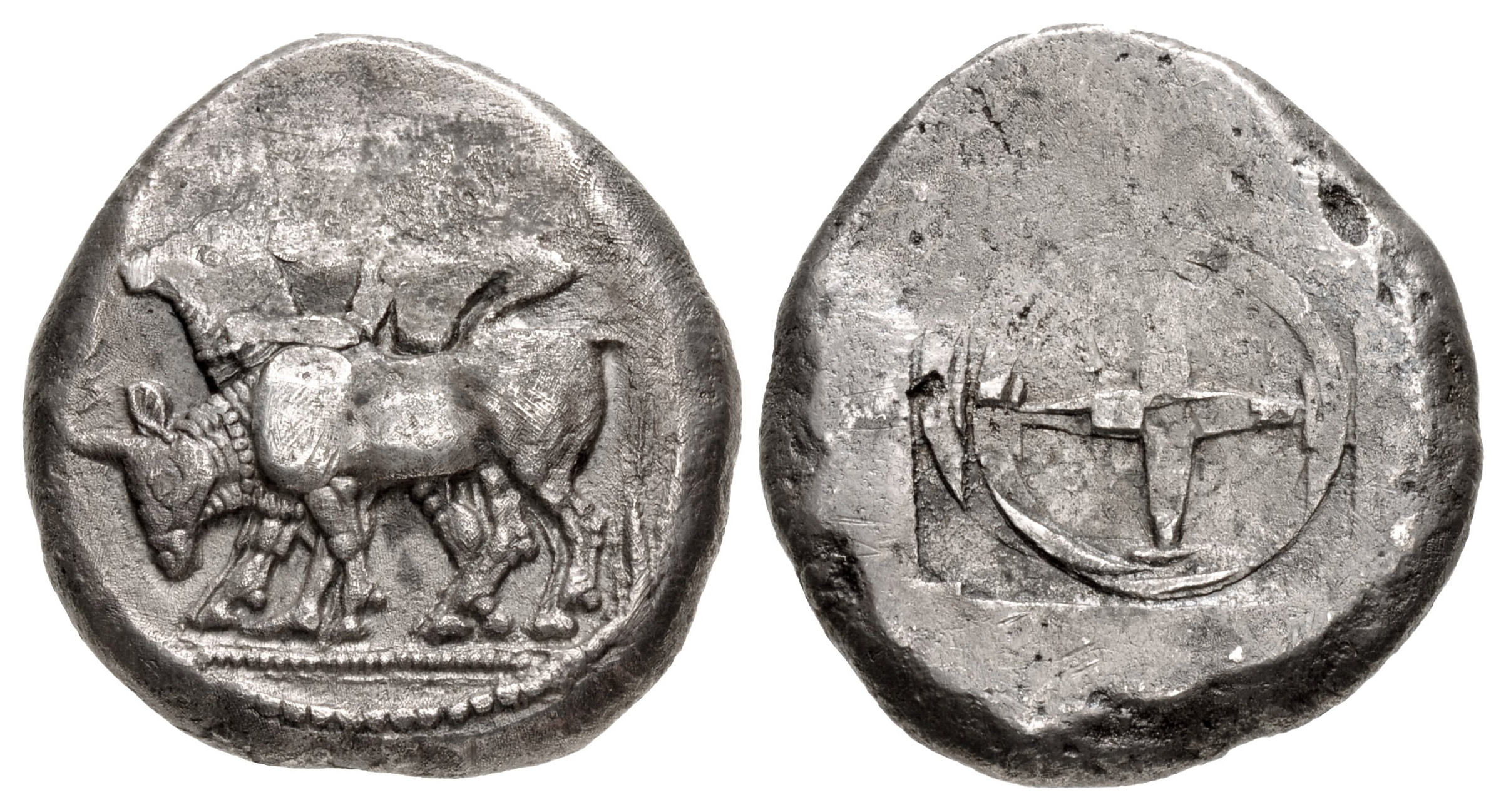S 1633 - Pangaion (uncertain mint) (Ichnai), silver, octodrachms (500-480 BCE)
From SILVER
500 BCE - 480 BCE Silver 11,705 kg
Description
| ObverseInscription or printing placed on the obverse.: | I-X-NAI above (Greek).Herdsman, wearing kausia, guiding two bulls walking left upon dotted ground line |
| ReverseInscription or printing placed on the reverse.: | Wheel with four spokes within shallow incuse square |
Mint and issuing power
| MintIdentifies the place of manufacture or issue of a numismatic object.: | Pangaion (uncertain mint) | Ancient regionAncient region.: | Macedonia | Modern countryModern country: Greece | AuthorityIdentifies the issuing power. The authority can be "pretended" when the name or the portrait of X is on the coin but he/she was not the issuing power. It can also be "uncertain" when there is no mention of X on the coin but he/she was the issuing power according to the historical sources: | Thraco-Macedonian tribes, Ichnai |
Chronology
| FromIdentifies the initial date in a range assigned in a numismatic context. | 500 BCE | toIdentifies the final date in a range assigned in a numismatic context.. | 480 BCE | PeriodTime period of the numismatic object.: Archaic until 480 BC |
Physical description
| MetalThe physical material (usually metal) from which an object is made.: | Silver |
Median weightMedian of the weights of numismatic objects (in grams). in grams | 28.90 | DenominationTerm indicating the value of a numismatic object. Examples: tetradrachm, chalkous, denarius.: | octodrachm |
StandardStandard.: | Reduced Aeginetic |
Image

S1633 Ichnai tridrachm.jpg [1]
References
| Die study referencePublication of the study: | Tzamalis 20121Tzamalis 2012, p. 175-178 (Group 2.4), Wartenberg 20152Wartenberg 2015 | ||
| Coin series referenceReference to coin series study: | Sear I3Sear I, n° 1316 | ||
Obverse dies distribution
Reverse dies distribution
no distribution is available
Quantification
| Number of obversesNumber of obverse dies. ᵖ (o) | 9 | Number of singletons (o1)The number of singleton coins. ᵖ | 5 |
| Number of reverse diesNumber of reverse dies. (r) | 10 | Number of coinsNumber of coins. (n) | 14 |
| Coins per obverse dieNumber of coins per obverse die. (n/o) | 1.56 | Coins per reverse dieNumber of coins per reverse die. (n/r) | 1.4 |
| Reverse per obverse ratioRatio of obverse dies divided by reverse dies. (r/o) | 1.11 | Percentage of singletons (o1)number of coins (n) divided by the number of singletons (o1) ᵖ | 55.56 % |
| Original number of dies (O) (Carter 1983 formula)The estimation of the number of coins according to Carter 1983 ᵖ | 20.25 | Coins struck if 20,000 as average productivity per dieCoins made if the average productivity for obverses (according to Carter) is 20,000. ᵖ | 405,000 |
| Original number of dies (O) (Esty 2011 formula)The estimation of the number of coins according to the singleton formula in Esty 2011 ᵖ (O) | 25.2 | Survival rate if 20,000 as average productivity per dieSurvival rate if average productivity is 20,000. ᵖ | 0.00003 |
| Coverage (o = % of O) (Esty 1984 formula)Esty 1984 - coverage (% of O) ᵖ (o = % of O) | 64.29% | Die productivity if survival rate 1/2,000Average productivity if survival rate is 1/2,000. ᵖ | 1,382.72 |
| Weight of silver (in kg) if 20,000 coins per die (O = Carter formula)Carter 1983 * Median weight * 20000 (*10 if gold or electrum) ᵖ | 11,705 kg <br /> 11,705 kg | Die productivity if survival rate 1/5,000Average productivity if survival rate is 1/5,000. ᵖ | 3,456.79 |
Remarks